urinary retention
· indications for placement of a urinary catheter. Contraindications.
· complications.
Types of catheters.
Types of urinals.
Basic abstract on the topic: "Bladder catheterization in men".
Bladder catheterization.
catheterization is the excretion of urine with therapeutic and
Diagnostic purpose using a catheter.
Indications for bladder catheterization:
n Acute urinary retention
n Bladder flush
n Administration of drugs
n Taking urine for research
n Retrograde administration of contrast agents (cystoureterography)
n Removal of blood clots (after operations and manipulations on the urinary tract)
Possible complications during catheterization:
Risk of urinary tract infection;
Risk of rupture and damage to the bladder.
Contraindication: bladder injury.
urinary retention

Acute urinary retention may occur in the first days after surgery or childbirth, after injuries. Often, acute urinary retention occurs as a psychological reaction of a previously healthy person to the need to use a urinal.
First of all, the nurse should try to induce urination by reflex. To do this, remove strangers from the room, protect the patient with a screen, transfer the patient from a horizontal position to another position convenient for him (with the permission of the doctor), open a tap with water, irrigate the genitals with warm water, or put a warm heating pad over the pubis - these measures can cause a reflex urination on their own.
If these measures are ineffective, a bladder catheterization is performed as prescribed by a doctor.
When preparing a patient for bladder catheterization, it should be borne in mind that this manipulation creates a significant psychological problem.
Therefore it is necessary:
Explain to the patient the purpose and course of manipulation,
Obtain consent to manipulation (if there is contact with the patient),
Create possible psychological comfort (calm down with a word, with your behavior and your actions during nursing intervention).
At chronic urinary retention , a severely distended bladder and catheterization for the first time, do not empty the bladder quickly, tk. after that, in frail older people with diseases of the cardiovascular system and reduced kidney function, the so-called emptying reaction may occur. It is expressed in violation of the excretory ability of the kidneys up to anuria and uremia. In such patients, urine is removed in small portions during each catheterization. If it is possible to pass a rubber catheter into the bladder, then it is left for a long time (permanent catheter).
Bladder catheterization is performed using urethral catheter.
Urethral catheter - a tube that is passed through the urethra to the bladder.
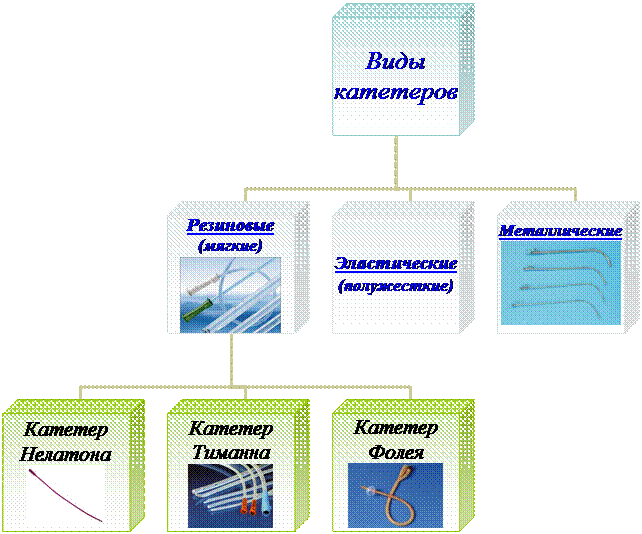
1. Nelaton catheter
- uniform thickness, about 25 cm long, with a rounded end; 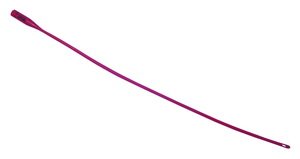
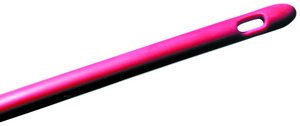
2. Tiemann catheter , having a narrowed, dense and somewhat curved end in the form of a beak. At its outer end there is a small comb indicating the direction of the beak;
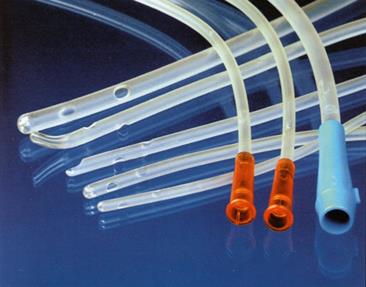
3. Foley catheter, having a length of 45 cm and a balloon filled with sterile water through a special outlet. The balloon allows you to fix the catheter in the urethra for a long time.
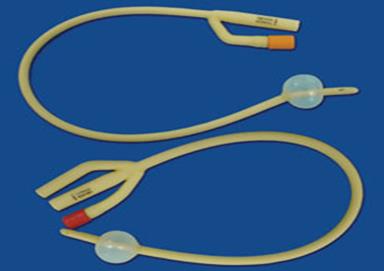
4. Elastic catheters somewhat narrowed at the blind end.
5. metal catheter consists of a handle, rod and beak. The length of the male catheter is 30 cm, the length of the female catheter is 12-15 cm with a small bent beak.
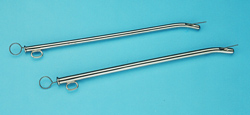
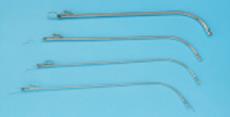
Female catheter Male catheter
ATTENTION! Elastic and metal catheters for men are introduced only by a doctor.
Bladder catheterization with a Foley catheter.
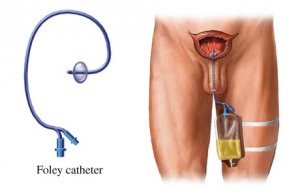
When catheterizing with a Foley catheter (Foley), a mandatory preliminary assessment of some parameters is required.
Depending on the expected period of stay of the catheter in the bladder, a catheter made of one or another material is selected:
§ catheter for short-term use (up to 28 days), made of plastic or latex;
§ catheter for long-term use (up to 3 months), made of latex, coated with silicone; from silicone; hydrogel coated latex.
Choosing the right catheter size is also important. For conventional drainage, the capacity of the balloon on the Foley catheter should be 10 ml. A larger balloon will touch the sensitive walls of the triangle of the bladder, which will cause discomfort to the patient. In the postoperative period, cylinders with a capacity of 30 ml more are used. Cylinders are recommended to be filled only with sterile water.
Prevention of nosocomial urinary tract infection in a patient with an indwelling urethral catheter.
Indwelling catheter (Foley), usually, 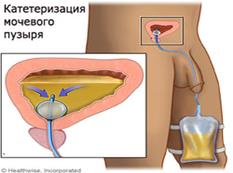 administered to a seriously ill person (after surgery, with a spinal injury with spinal cord injury, in an unconscious state, etc.).
administered to a seriously ill person (after surgery, with a spinal injury with spinal cord injury, in an unconscious state, etc.).
A seriously ill patient is at high risk of developing nosocomial infections, including urinary tract infections. In this regard, a patient with an indwelling catheter needs careful care.
The risk of infection associated with the use of a catheter increases every day by 5-8%, starting from the moment of catheterization and is almost inevitable with long-term catheterization.
AT non-catheterized In the bladder, there are two main mechanisms of immune defense against urinary tract infection - the mechanical clearance of microorganisms and the intrinsic antibacterial properties of the bladder wall.

Mechanisms for increasing the risk of urinary tract infection in catheterized patients:
 The interplay of all these mechanisms involved in the pathogenesis of colonization and urinary tract infection makes it extremely difficult to prevent urinary tract infection in patients with urinary catheters.
The interplay of all these mechanisms involved in the pathogenesis of colonization and urinary tract infection makes it extremely difficult to prevent urinary tract infection in patients with urinary catheters.
To prevent a nosocomial urinary tract infection in a patient with an indwelling catheter, the following conditions should be observed:
Insert the catheter strictly following the rules of asepsis, in atraumatic ways;
Securely fasten the catheter to avoid falling out of the urethra;
Keep the catheter no longer than necessary;
If possible, use an external catheter (in men);
Wash hands before and after any manipulation with the catheter and urinal;
Make sure that the catheter - urinal system is closed; disconnect it only if it is necessary to flush the catheter;
Flush the catheter only if a blockage is suspected;
If it is necessary to flush the catheter, observe all asepsis rules;
If necessary, take a urine sample for analysis, disinfect the free end of the catheter or its outlet with an antiseptic, and aspirate urine using a sterile needle and syringe;
Carefully disconnect the urinal, avoiding contamination of the connecting tube;
Maintain a constant flow of urine;
Place the urine container below the level of the bladder;
Do not pinch the catheter;
Wash the area around the catheter with soap and water 2 times a day.
To prevent nosocomial infection in a patient with an indwelling urinary catheter, careful care of the patient's perineum and inserted catheter should be performed (see Algorithm #2 Perineal care of a patient with a urinary catheter).
REMEMBER! Microorganisms gain access to the urinary tract in two ways:
Through the lumen at the junction of the catheter and urinal;
On the outer surface of the catheter.
Possible violations in the operation of the "catheter - drainage bag" system, their elimination:
If there is no drainage (outflow) of urine:
Check if the system pipes are twisted;
Find out if the patient has constipation;
Check the condition of the catheter: there are no formations on it that change the patency of the system.
If there is blood in the urine (hematuria):
A small amount of blood may be caused by trauma during catheterization, or a urinary tract infection;
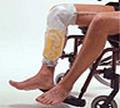 If there is a lot of blood in the urine, tell your doctor immediately.
If there is a lot of blood in the urine, tell your doctor immediately.
If urine leaks past the catheter:
Check if the system pipes are twisted;
Determine if the patient is constipated;
Change the catheter, inspect it for the formation of urinary stones;
Increase the patient's fluid intake to reduce urine concentration;
Check if the patient has persistent signs of a urinary tract infection;
Tell your doctor about any changes you find.
For pain in the bladder area:
Change the catheter you are using to a smaller catheter.
Urine collection systems (urinals)
These devices can be fixed both on the patient's body (if he walks),
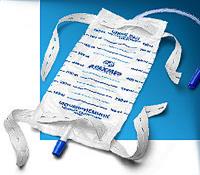
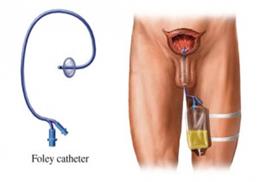
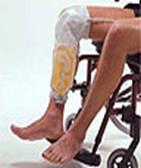
and next to the patient, for example, on the bed frame.
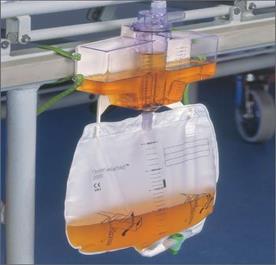 Optimally, the catheter and drainage bag can be connected within 5-7 days. There are a wide variety of drainage systems and the choice of one or another device depends on the purpose of catheterization and on its expected duration.
Optimally, the catheter and drainage bag can be connected within 5-7 days. There are a wide variety of drainage systems and the choice of one or another device depends on the purpose of catheterization and on its expected duration.
The size of the urinal (drainage bag), the connecting tube, and the ease and ease of draining the collected urine are all important factors to consider.
To ensure a good outflow of urine, the receptacle must be located below the level of the bladder. This is especially important at night: the tube through which the outflow is carried out should not be twisted, as this can lead to a violation of the outflow of urine through the catheter.
When draining urine, be sure to use gloves, as well as wash your hands both before and after the procedure. (see Algorithm #3 Emptying the Urinary Drainage Bag).
Algorithms for performing manipulations on the topic: "Catheterization of the bladder in men."
ALGORITHM #1. Bladder catheterization in men with a rubber catheter and a Foley catheter.
 Indications: acute urinary retention, bladder lavage, injection of drugs into the bladder, urine collection for examination. Contraindications: acute inflammation of the urethra and bladder, trauma to the urethra.
Indications: acute urinary retention, bladder lavage, injection of drugs into the bladder, urine collection for examination. Contraindications: acute inflammation of the urethra and bladder, trauma to the urethra.
Complications: perforation of the wall of the urethra, nosocomial infections, urinary tract infection.
Equipment: sterile catheter, rubber gloves - 2 pairs, sterile glycerin, furacillin solution, 10 ml of isotonic sterile solution, forceps, sterile instrument tray, 2 tweezers, oilcloth, bedpan, waste material tray, sterile wipes, jug with a weak solution of potassium permanganate , soap.
The course of the procedure.
| Stages | Rationale | ||
| 1. Preparation for the procedure | |||
| 2. Prepare equipment. | |||
| Ensuring infectious safety. | |||
| 6. Wash the patient. | Ensuring infectious safety. | ||
| 7. Remove gloves and throw them into a waterproof container, put on sterile gloves. | Ensuring infectious safety. | ||
| II. Performing a procedure | |||
| 8. Stand to the right of the patient, take a sterile napkin in your left hand and wrap the penis below the head with it. | Ensuring the psychological comfort of the patient. | ||
| 9. Take the penis with the 3rd and 4th fingers of the left hand, slightly squeeze the head, push the foreskin with the 1st and 2nd fingers. | Providing access to the external opening of the urethra. | ||
| 10. Take a gauze swab with tweezers, clamped in your right hand, moisten it in a solution of furacillin and treat it with the external opening of the urethra and the head of the penis in a clockwise direction. | Ensuring infectious safety. | ||
| 11. Place the tweezers and tissue in the waste tray. | |||
| 12. Have an assistant open the catheter package. Remove the catheter from the package with tweezers: keep at a distance of 5-6 cm from the side hole, hold the outer end of the catheter with IV-V fingers. | Ensuring the necessary conditions of asepsis. | ||
| 13. Ask an assistant to generously lubricate the beak of the catheter with sterile glycerin. | Facilitate the introduction of a catheter into the urethra. | ||
| 14. Insert the catheter into the urethra and gradually, intercepting the catheter, move it deeper into the urethra, and “pull” the penis up, as if pulling it onto the catheter for a length of 19-20 cm. | Accounting for the anatomical features of the urethra in men. | ||
| 15. Lower the edge of the catheter into the urinal (connect the Foley catheter to the urine collection container, attach the indwelling catheter tube to the thigh). | Prevention of urine contact with surrounding objects. | ||
| 16. Fill the balloon of the Foley catheter with 10 ml of isotonic saline. | Ensuring fixation of the catheter. | ||
| 17. Observe the excretion of urine, when it drops, press with your left hand on the anterior abdominal wall, above the pubis, while removing the catheter with your right hand, holding its outer end. | Ensuring that the urethra is flushed with residual urine. | ||
| 18. Place the catheter in the waste tray. | Ensuring infectious safety. | ||
| 19. Remove the diaper, oilcloth and place them in a bag for used material. | Ensuring infectious safety. | ||
| 20. Remove gloves, wash hands. | Ensuring infectious safety. | ||
| 21. Help the patient to take a comfortable position, cover him, find out how he is feeling. | |||
| III. Completion of the procedure | |||
| 22. Disinfect the used material with subsequent disposal of the disposable. | Ensuring infectious safety. | ||
| 23. Wash your hands (social method). | Ensuring infectious safety. | ||
| 24. Make a record of the procedure and the patient's well-being. | |||

 Algorithm number 2. Perineal care of a patient with a urinary catheter.
Algorithm number 2. Perineal care of a patient with a urinary catheter.
Indications: prevention of urinary tract infection;
Equipment: terry cloth gloves (forceps + napkins), towel, gloves, absorbent diaper (oilcloth and regular diaper), water container, cotton balls.
The course of the procedure.
| Stages | Rationale | ||
| 1. Preparation for the procedure | |||
| 1. Explain to the patient the essence and course of the upcoming procedure and obtain his consent. | Psychological preparation. Ensuring the patient's right to information. | ||
| 2. Prepare equipment. | A necessary condition for the effectiveness of the procedure. | ||
| H. Wash your hands (hygienic level); put on gloves. | Ensuring infectious safety. | ||
| 4. Place an absorbent pad under the patient's pelvis (or an oilcloth and a diaper) | Ensuring infectious safety. | ||
| 5. Help the patient to take the position necessary for the procedure: on the back with half-bent legs apart (“frog leg” position). | Necessary condition of the procedure. | ||
| II. Performing a procedure | |||
| 6. Wash the patient. | Ensuring infectious safety. | ||
| 7. Wash with cotton swabs and then dry 10 cm of the catheter from the site where it exits the urethra. | Ensuring infectious safety. | ||
| 8. Examine the urethral area around the catheter: make sure that urine does not leak. | Prevention of violations in the operation of the "catheter - drainage bag" system, their elimination. | ||
| 9. Examine the skin of the perineum for signs of infection (hyperemia, swelling, skin maceration, purulent discharge). | Presence of signs of a urinary tract infection; Ensuring infectious safety | ||
| 10. Help the patient to take a comfortable position, cover him, find out how he is feeling. | Ensuring psychological safety. | ||
| III. Completion of the procedure | |||
| 11. Make sure the catheter tube is plastered to the thigh and not pulled tight. | Ensuring fixation of the catheter, good urine outflow | ||
| 12. Make sure the drainage bag is attached to the bed. | Ensuring a good outflow of urine, (the urinal should be located below the level of the bladder). | ||
| 13. Remove the diaper (oilcloth with a diaper) from the bed and throw it into a waterproof bag. | |||
| 14. Disinfect the used material with subsequent disposal of the disposable. | Ensuring infectious safety. | ||
| 15. Remove gloves, wash hands (social method). | Ensuring infectious safety. | ||
| 16. Make a record of the procedure and the patient's well-being. Report to the doctor about the signs of inflammation in the perineum. | Ensuring continuity of care. | ||

Algorithm No. 3. Emptying the urinary drainage bag

Equipment: gloves, a measuring container for collecting and measuring the amount of urine, a swab with alcohol, a trash can
The course of the procedure.
| Stages | Rationale | ||
| 1. Preparation for the procedure | |||
| 1. Explain to the patient the essence and course of the upcoming procedure and obtain his consent. | Psychological preparation. Ensuring the patient's right to information. | ||
| 2. Prepare equipment. | A necessary condition for the effectiveness of the procedure. | ||
| H. Wash your hands (hygienic level); put on gloves. | Ensuring infectious safety. | ||
| Place a measuring container under the outlet tube of the drainage bag. | Ensuring infectious safety. | ||
| II. Performing a procedure | |||
| 4. Release the outlet tube from the holder; open the tube clamp; drain the urine into a measuring container. Note. The outlet tube must not touch the walls of the measuring container or the floor. Note. Squat down instead of leaning forward. | Prevention of ingress of urine on the surrounding objects. Ensuring infectious safety. Spinal Injury Prevention m/s | ||
| 5. Close the clamp. Wipe the end of the outlet tube with a swab with alcohol. Attach the outlet tube to the holder. | Prevention of infection of the urinary tract. Ensuring infectious safety. | ||
| 6. Help the patient to take a comfortable position, cover him, find out how he feels. | Ensuring psychological safety. | ||
| III. Completion of the procedure | |||
| 7. Make sure that the tubes connecting the catheter and the drainage bag are not kinked. | Ensuring a good flow of urine | ||
| 8. Disinfect the used material with subsequent disposal of the disposable. | Ensuring infectious safety. | ||
| 9. Remove gloves, wash hands (social method). | Ensuring infectious safety. | ||
| 10. Report to the doctor and / or make a record of the amount of urine, the time of its measurement, the color, smell and transparency of the urine, the patient's well-being. | Ensuring continuity of care. | ||




